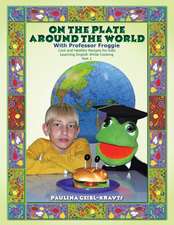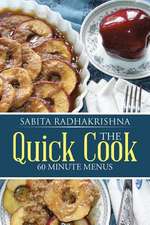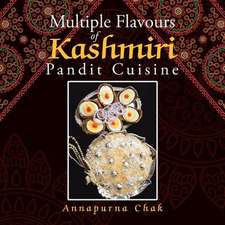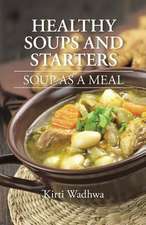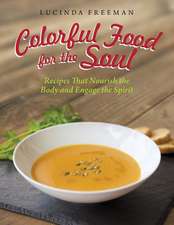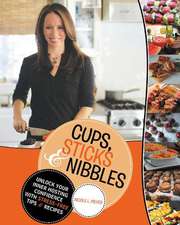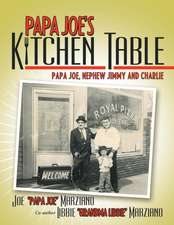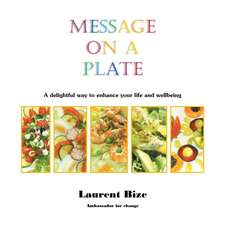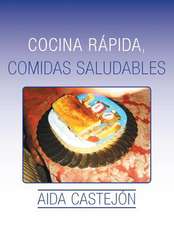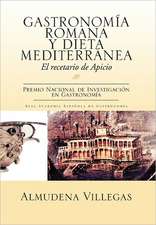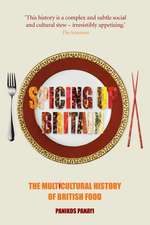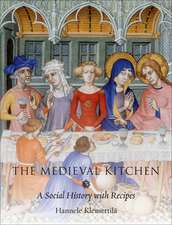Edible Flowers: A Global History: Edible
Autor Mary Newman, Constance L. Kirkeren Limba Engleză Hardback – 15 oct 2016
Most of us like to look at them, but why on earth would anyone want to eat them? As Constance L. Kirker and Mary Newman show in this book, however, flowers have a long history as a tasty ingredient in a variety of cuisines. The Greeks, Romans, Persians, Ottomans, Mayans, Chinese, and Indians all knew how to cook with them for centuries, and today contemporary chefs use them to add something special to their dishes.
Edible Flowers is the fascinating history of how flowers have been used in cooking, from ancient Greek dishes to the today’s molecular gastronomy and farm-to-table restaurants. Looking at flowers’ natural qualities: their unique and beautiful appearance, their pungent fragrance, and their surprisingly good taste, Kirker and Newman proffer a bouquet of dishes—from soups to stews to desserts to beverages—that use them in interesting ways. Tying this culinary history into a larger cultural one, they show how flowers’ cultural, symbolic, and religious connotations have added value and meaning to dishes in daily life and special occasions. From fried squash blossoms to marigold dressings, this book rediscovers the flower not just as something beautiful but as something absolutely delicious.
Edible Flowers is the fascinating history of how flowers have been used in cooking, from ancient Greek dishes to the today’s molecular gastronomy and farm-to-table restaurants. Looking at flowers’ natural qualities: their unique and beautiful appearance, their pungent fragrance, and their surprisingly good taste, Kirker and Newman proffer a bouquet of dishes—from soups to stews to desserts to beverages—that use them in interesting ways. Tying this culinary history into a larger cultural one, they show how flowers’ cultural, symbolic, and religious connotations have added value and meaning to dishes in daily life and special occasions. From fried squash blossoms to marigold dressings, this book rediscovers the flower not just as something beautiful but as something absolutely delicious.
Din seria Edible
- 17%
 Preț: 85.77 lei
Preț: 85.77 lei - 5%
 Preț: 85.77 lei
Preț: 85.77 lei - 18%
 Preț: 84.68 lei
Preț: 84.68 lei - 5%
 Preț: 85.77 lei
Preț: 85.77 lei - 18%
 Preț: 84.68 lei
Preț: 84.68 lei - 18%
 Preț: 83.87 lei
Preț: 83.87 lei - 5%
 Preț: 86.41 lei
Preț: 86.41 lei - 18%
 Preț: 84.68 lei
Preț: 84.68 lei -
 Preț: 89.71 lei
Preț: 89.71 lei - 17%
 Preț: 85.24 lei
Preț: 85.24 lei -
 Preț: 104.02 lei
Preț: 104.02 lei - 6%
 Preț: 84.15 lei
Preț: 84.15 lei - 18%
 Preț: 84.78 lei
Preț: 84.78 lei - 18%
 Preț: 83.97 lei
Preț: 83.97 lei - 18%
 Preț: 84.68 lei
Preț: 84.68 lei - 17%
 Preț: 85.70 lei
Preț: 85.70 lei - 18%
 Preț: 84.68 lei
Preț: 84.68 lei -
 Preț: 108.35 lei
Preț: 108.35 lei - 18%
 Preț: 84.15 lei
Preț: 84.15 lei - 10%
 Preț: 99.13 lei
Preț: 99.13 lei - 17%
 Preț: 86.15 lei
Preț: 86.15 lei - 17%
 Preț: 85.24 lei
Preț: 85.24 lei - 6%
 Preț: 84.50 lei
Preț: 84.50 lei - 17%
 Preț: 85.24 lei
Preț: 85.24 lei - 18%
 Preț: 84.68 lei
Preț: 84.68 lei - 16%
 Preț: 87.51 lei
Preț: 87.51 lei - 16%
 Preț: 88.71 lei
Preț: 88.71 lei - 18%
 Preț: 84.32 lei
Preț: 84.32 lei - 17%
 Preț: 85.60 lei
Preț: 85.60 lei - 17%
 Preț: 85.77 lei
Preț: 85.77 lei - 18%
 Preț: 84.68 lei
Preț: 84.68 lei - 17%
 Preț: 86.41 lei
Preț: 86.41 lei - 5%
 Preț: 85.95 lei
Preț: 85.95 lei - 17%
 Preț: 85.70 lei
Preț: 85.70 lei - 5%
 Preț: 85.24 lei
Preț: 85.24 lei - 5%
 Preț: 86.41 lei
Preț: 86.41 lei - 18%
 Preț: 84.78 lei
Preț: 84.78 lei - 5%
 Preț: 85.70 lei
Preț: 85.70 lei - 18%
 Preț: 84.15 lei
Preț: 84.15 lei -
 Preț: 141.15 lei
Preț: 141.15 lei -
 Preț: 90.25 lei
Preț: 90.25 lei - 17%
 Preț: 85.24 lei
Preț: 85.24 lei - 5%
 Preț: 85.24 lei
Preț: 85.24 lei -
 Preț: 164.88 lei
Preț: 164.88 lei -
 Preț: 89.71 lei
Preț: 89.71 lei - 17%
 Preț: 85.77 lei
Preț: 85.77 lei - 17%
 Preț: 85.70 lei
Preț: 85.70 lei - 17%
 Preț: 86.41 lei
Preț: 86.41 lei - 17%
 Preț: 85.70 lei
Preț: 85.70 lei
Preț: 85.77 lei
Preț vechi: 103.52 lei
-17% Recomandat
Puncte Express: 129
Preț estimativ în valută:
15.18€ • 17.74$ • 13.18£
15.18€ • 17.74$ • 13.18£
Carte disponibilă
Livrare economică 30 ianuarie-06 februarie
Livrare express 15-21 ianuarie pentru 129.84 lei
Preluare comenzi: 021 569.72.76
Specificații
ISBN-13: 9781780236384
ISBN-10: 1780236387
Pagini: 144
Ilustrații: 45 color plates, 15 halftones
Dimensiuni: 127 x 197 x 20 mm
Greutate: 0.37 kg
Editura: REAKTION BOOKS
Colecția Reaktion Books
Seria Edible
ISBN-10: 1780236387
Pagini: 144
Ilustrații: 45 color plates, 15 halftones
Dimensiuni: 127 x 197 x 20 mm
Greutate: 0.37 kg
Editura: REAKTION BOOKS
Colecția Reaktion Books
Seria Edible
Notă biografică
Before retiring, Constance L. Kirker was professor of art history at Pennsylvania State University. She has written extensively on food history. Mary Newman has taught at Ohio University and the University of Malta and is a member of the International Association of Culinary Professionals.
Cuprins
Introduction
1 The Ancient World
2 The Middle Ages to the Nineteenth Century
3 The Victorian Era to Today
4 Asia
5 The Mediterranean and the Middle East
6 Europe
7 The Americas
Afterword
Precautions When Eating Edible Flowers
Flower Dinner Menu
Recipes
Select Bibliography
Websites and Associations
Acknowledgements
Photo Acknowledgements
Index
1 The Ancient World
2 The Middle Ages to the Nineteenth Century
3 The Victorian Era to Today
4 Asia
5 The Mediterranean and the Middle East
6 Europe
7 The Americas
Afterword
Precautions When Eating Edible Flowers
Flower Dinner Menu
Recipes
Select Bibliography
Websites and Associations
Acknowledgements
Photo Acknowledgements
Index
Recenzii
"Broad in scope, Kirker’s work explains the use of edible flowers from ancient times to the present day . . . It is a whistlestop tour that stays engaging and the history doesn’t simply cherry pick the sentimental stories . . . The book also contains flower-based recipes as well as precautions for eating flowers and, perhaps unlike some of the crops mentioned, it is very easy to digest."
"This neat little book is part of a fascinating series called Edible, in which each volume explores the rich history of individual foods and drink – from Apple to Whisky, with diversions en route to Olives, Nuts, Onions and Garlic. Did you know that the Romans believed that eating calendula helps you to see fairies? Maybe you want to cook Beef with Rosebuds? A surprising and enjoyable read."
“This beautifully illustrated, delightful book is one in the long-standing series ‘Edible,’ which focuses on the history of the consumption of specific foods. The authors classify and describe flowers that have been consumed in a variety of ways (according to geographic location) and provide a time line of when these flowers were used (the ancient world, the Middle Ages, etc.). Flowers and other parts of plants have been used with foods in many ancient cultures—the Chinese, Greeks, and Romans incorporated flowers into food. This practice has continued—for colorful use, delicate flavor, as well as some nutritional qualities. Recommended.”
"Kirker and Newman take us on a journey to the past, going back to the Egyptians, the Greeks, and the Romans, and around the world, to discover intriguing traditions and symbols."

